by Martin Green
Before going on vacation (remember those?), one of the most important questions I ask myself is, “Which watch am I going to take?”
Some of you might recognize this dilemma. When I travel, I prefer to take just one watch to avoid having to leave watches in a hotel. This puts quite a bit of pressure on that single watch because, as an avid watch enthusiast and journalist, I am used to changing watches sometimes several times a day.
One of the things I enjoy most about vacation is having as little to worry about as possible. That means in terms of my watch I am looking for a versatile, leisurely partner that is as suitable for hiking as it is for drinks and dinner afterward.
While dress watches are my preferred poison most days of the week, I like something slightly more rugged for vacation. No precious metals as they tend to scratch more easily and can attract unwanted attention.
I generally like to travel in style, but my watch shouldn’t be too expensive as I don’t want to have to be too careful with it. Not that I bang around any watch, but a less expensive timepiece makes for more of a care-free experience on vacation.
Fortunately these days, spending less doesn’t mean that you have to be ashamed of what’s on your wrist. And the following three watches deliver both style and quality at competitive price points, making them very enjoyable travel companions.
Maurice Lacroix Aikon Venturer GMT
For Maurice Lacroix, the Aikon is quite a success story.
It’s not that difficult to understand as the Aikon is charismatic, well made, and smartly priced. Some collectors hammer on the fact that it bears a resemblance to the Audemars Piguet Royal Oak, perhaps not realizing that the Aikon looks far more like its predecessor from the 1980s and 1990s, the Calypso, a watch with little in common with the Royal Oak.
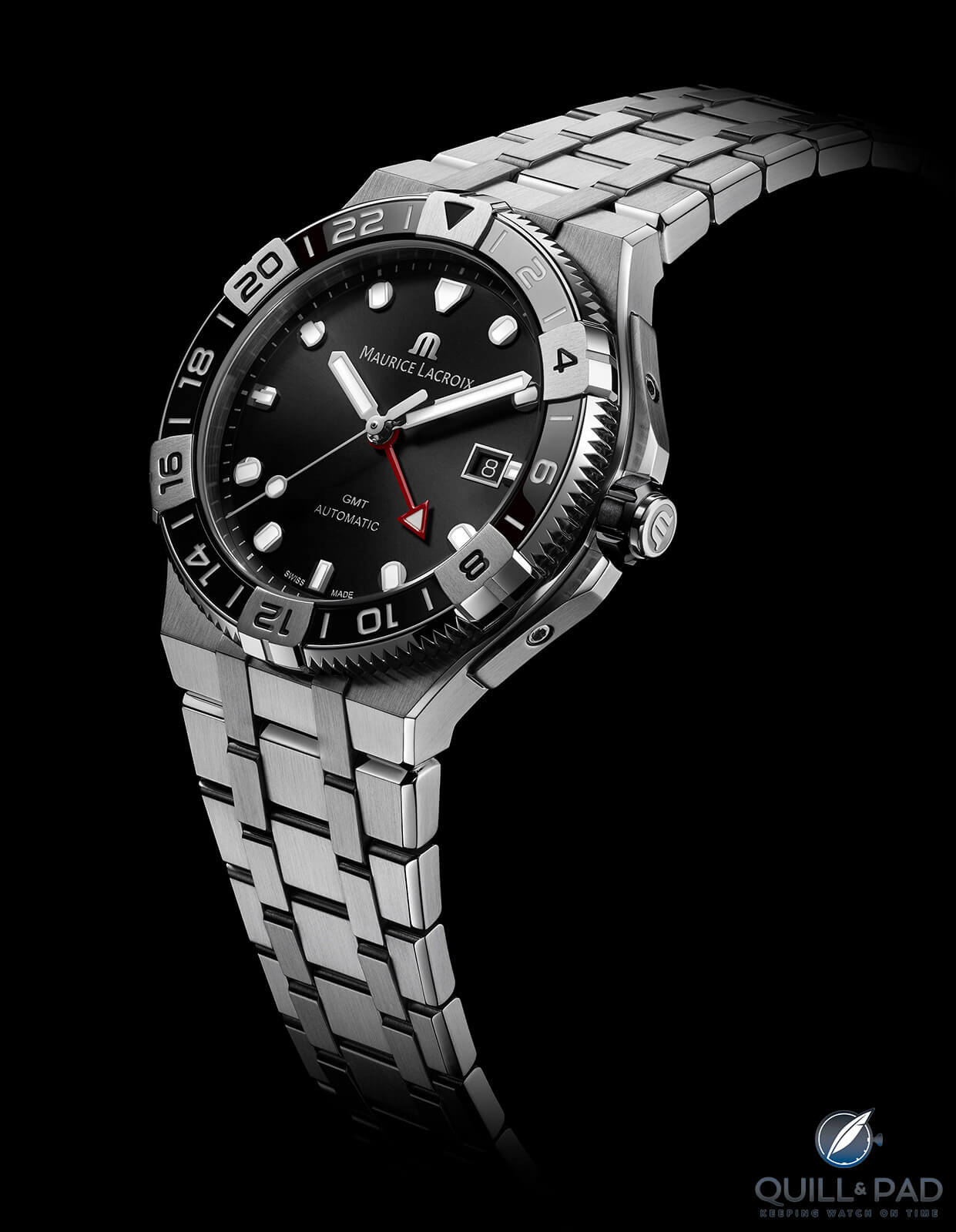
Maurice Lacroix Aikon Venturer GMT
In recent years, Maurice Lacroix has cleverly built up the Aikon collection, recently adding the Aikon Venturer GMT to the lineup.
The Aikon Venturer GMT effortlessly ticks a lot of boxes. With it, Maurice Lacroix has recaptured some of its 1990s swing; its design is very balanced. At 43 mm, it is not the smallest watch, but thanks to a generously sized bezel it doesn’t look too big.
The bezel’s two-tone design, in which the black segments are made of ceramic, sets it cleverly apart from other GMT watches in the market, while bold hands and hour markers ensure perfect legibility. In the black-dial version, the Aikon Venturer GMT is modestly restrained, while a sunburst effect on the dial adds a play of light.
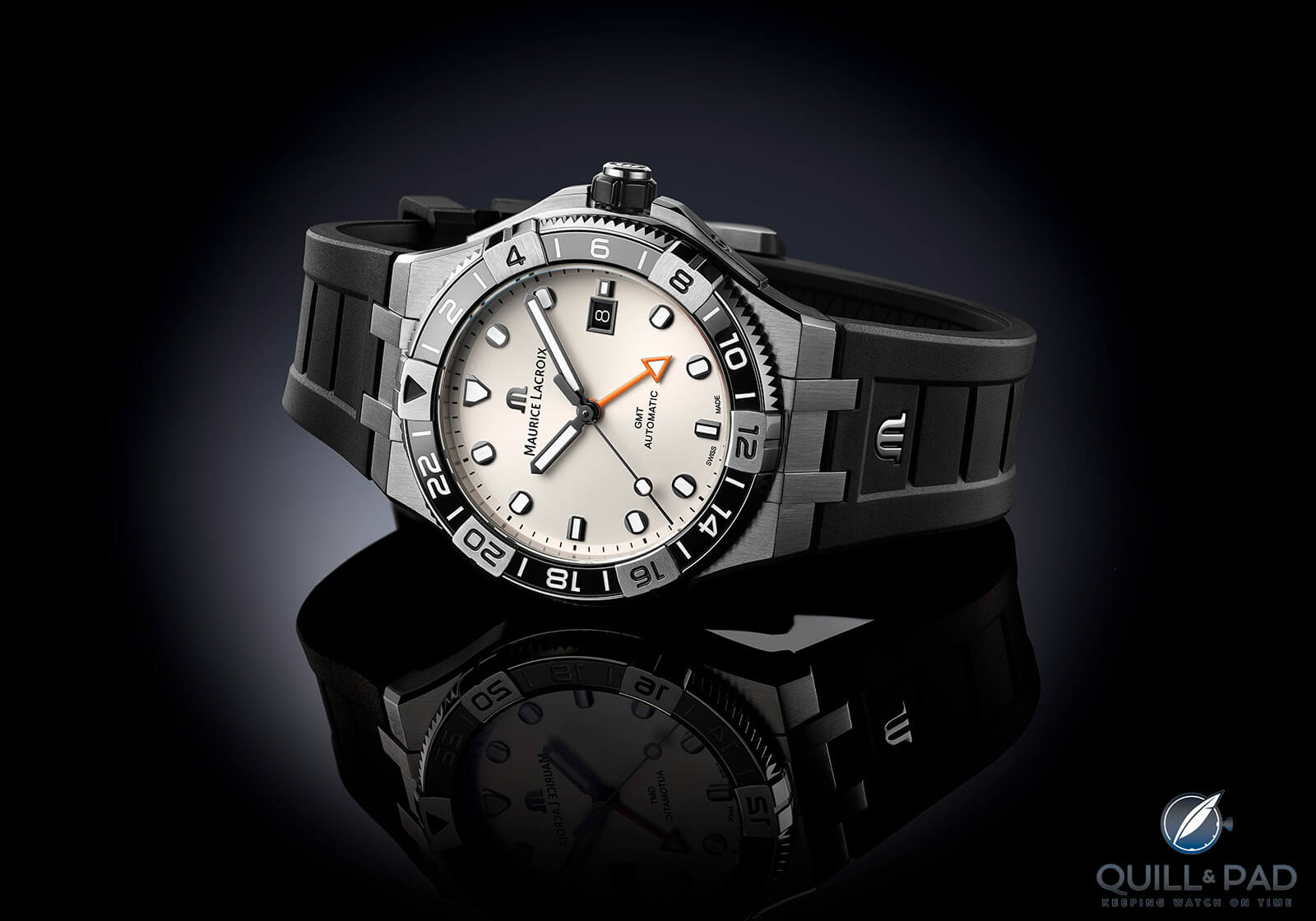
Maurice Lacroix Aikon Venturer GMT
I am quite taken with the silver dial with the same effect. It is something of a bolder creation with an orange GMT hand adding a prominent dash of color.
In terms of design, I also applaud Maurice Lacroix for opting for a black background on the date disk and keeping the text on the dial to a minimum: the brand doesn’t even boast this watch’s water resistance to an impressive 300 meters, a depth even most diver’s watches don’t reach.
The Aikon Venturer GMT has a closed case back. While Caliber ML 165 is an ample performer, it is based on the Sellita SW330, a movement with nothing to complain about in terms of reliability but not the most spectacular looking.
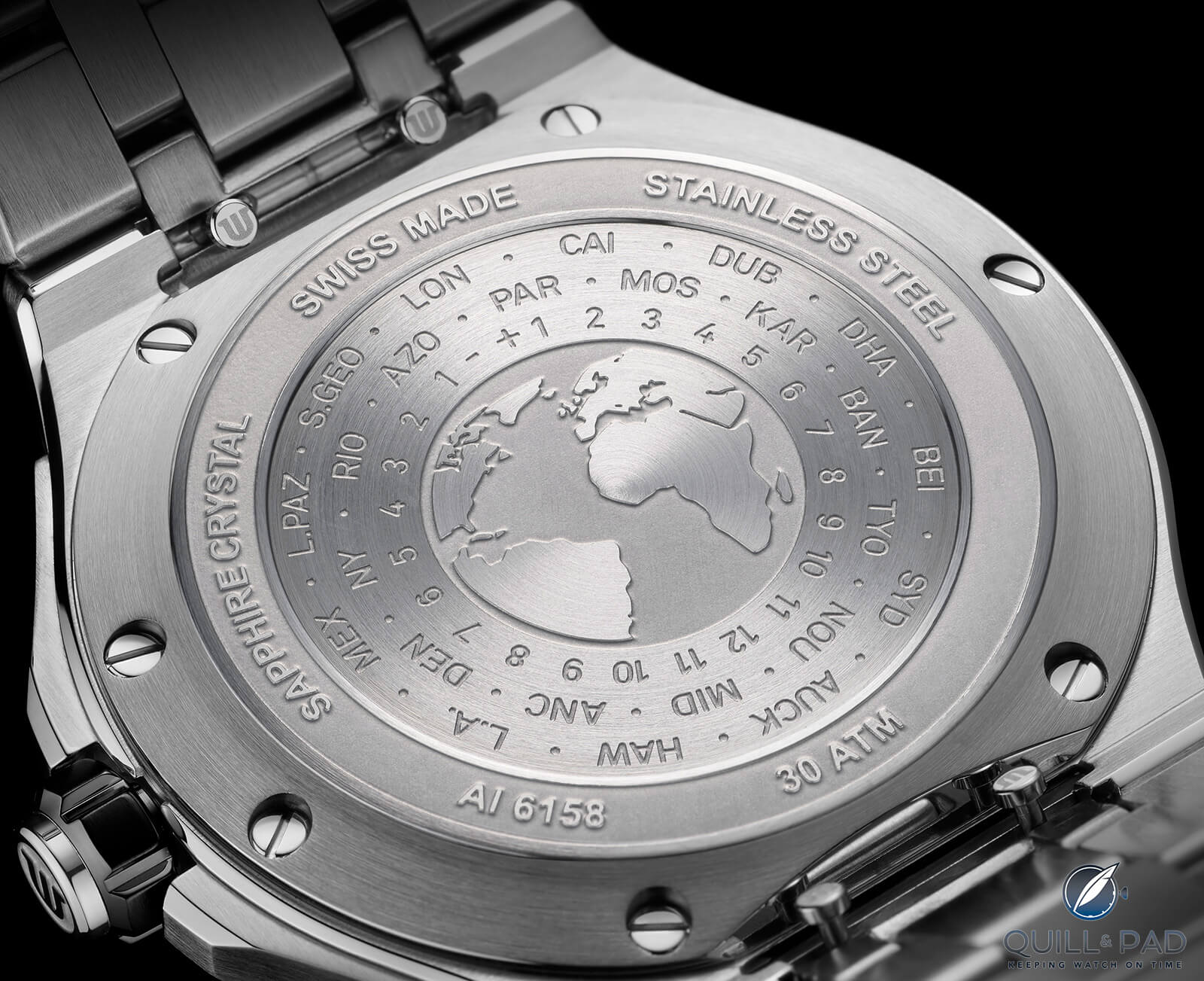
Back of the Maurice Lacroix Aikon Venturer GMT
The diameter is also substantially smaller than the 43 mm case, so Maurice Lacroix made the right choice not to show it off. The solid case back impresses more as it is secured by eight screws and engraved with time zone indications and a Mercator projection of part of the world.
Would I ever use the map on the back? Probably not. But it fits nicely into the theme and, honestly, it is also so cool that when you take off your watch at night you’ll probably be delighted by it.
It is interesting to note that Maurice Lacroix is asking €2,490 for the Aikon Venturer GMT on a stainless steel bracelet and €2,350 on a rubber strap. However, if you spend just a little more (€2,650) you get them both.
This would definitely be my advice: as I dislike taking more than one watch when I travel and thanks to its convenient quick-change system I appreciate the option of changing from a bracelet to a strap in the blink of an eye.
That’s a pretty perfect travel watch right there.
For more information, please visit www.mauricelacroix.com/ch_en/news/aikon-venturer-gmt.
Quick Facts Maurice Lacroix Aikon Venturer GMT
Case: 43 x 12 mm, stainless steel, unidirectional black ceramic and stainless steel bezel with 24-hour markings, 300 meters water resistance
Movement: automatic Caliber ML 165 (base Sellita SW 330), 4 Hz/28,800 vph frequency, 42-hour power reserve
Functions: hours, minutes, seconds; date, second time zone
Price: €2,350 (rubber strap); €2,490 (stainless steel bracelet); € 2,650 (set including both)
Montblanc Heritage GMT
For a long time the word “Montblanc” was to me synonymous with outstanding (fountain) pens – so much so that I found it awkward to see the same logo on the dial of a watch.
In recent years, however, this feeling has faded away – for two reasons: firstly, places where Montblanc (fountain) pens can be purchased are becoming rarer and rarer as so few specialized retailers are left. Secondly, the brand’s watches became exponentially more attractive, at least to my eyes, when Montblanc’s designers began looking for inspiration in the 1940s and 1950s designs of Minerva – the movement manufacture purchased by parent company Richemont in 2006.
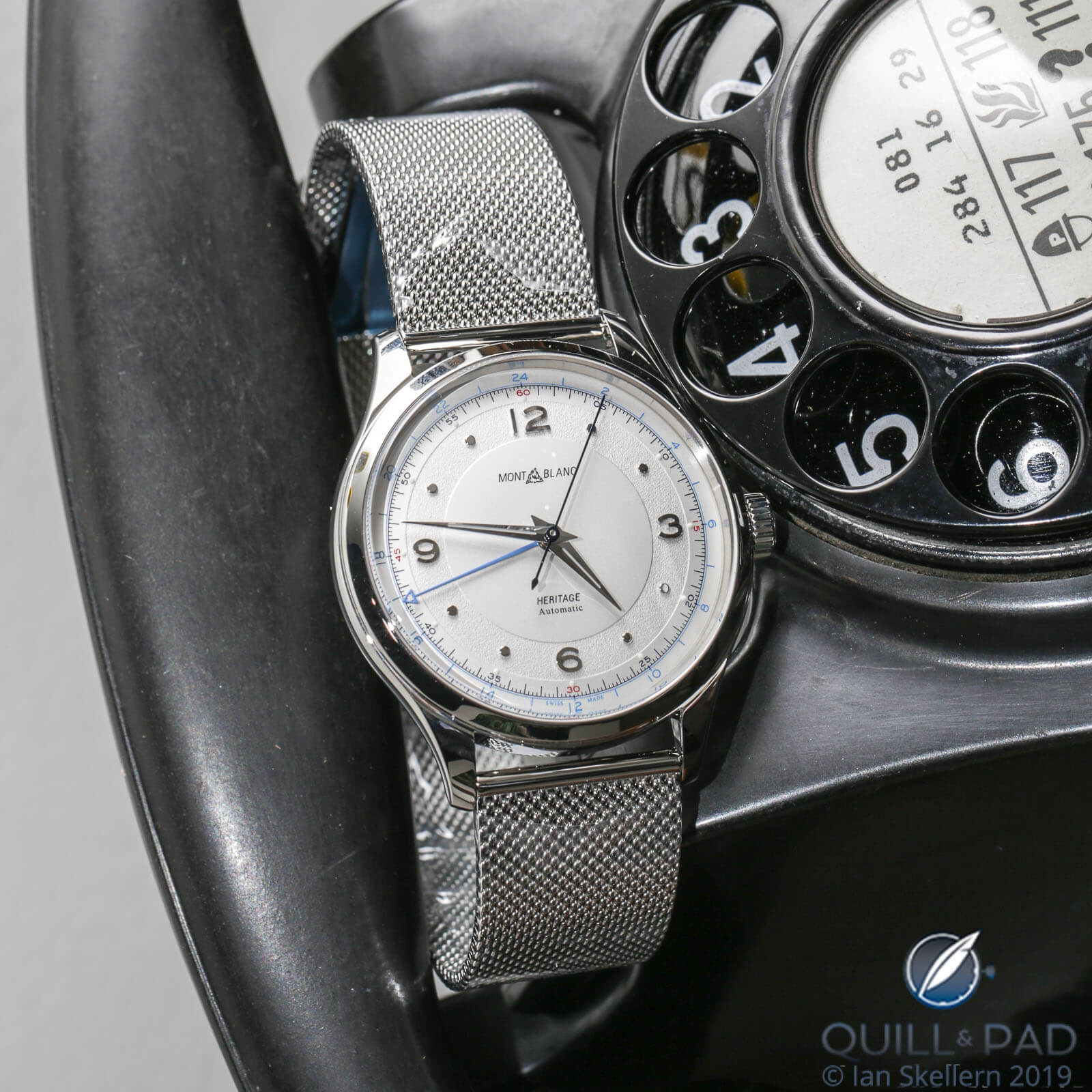
Montblanc Heritage GMT
The Montblanc Heritage GMT is quite a different animal than the Maurice Lacroix Aikon Venturer GMT. It’s more the type of watch for exploring a beautiful city rather than going on a safari or backpacking.
Thanks to being fairly slim, with its 40 mm case the Heritage GMT oozes elegance. The design is not overly special but doesn’t need to be because the dial amply fulfills that function. With its subtle, varied dial finishes, the Heritage GMT emits real character, especially if you opt for the pink/salmon dial.
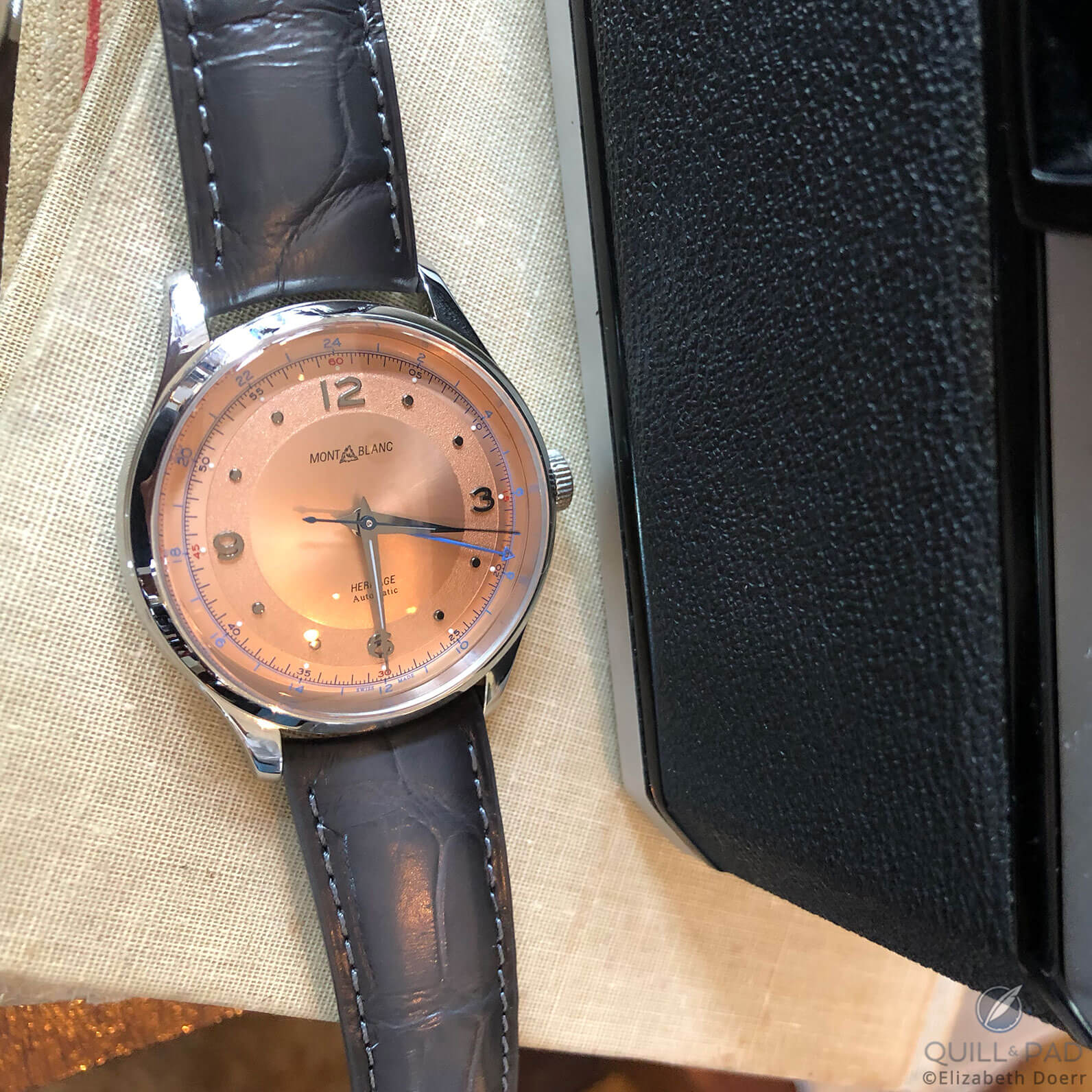
Montblanc Heritage Automatic GMT with salmon dial
Applied Arabic numerals and hour markers add to the watch’s vintage feel, as does the box sapphire crystal. Montblanc was right not include a date even though the movement inside supports one. It makes the Heritage GMT so much purer.
While it may not be suitable for diving, a water resistance of 50 meters makes the Heritage GMT more than ample for splashing around and most vacation activities.
Combined with a stainless steel case and sapphire crystal, the watch isn’t as fragile as it may look, especially not when you also opt for the Milanese bracelet rather than the leather strap.

Montblanc Heritage Automatic GMT with salmon dial
Like Maurice Lacroix, Montblanc also opted for a closed case back. Inside is Caliber MB 24.05, which is based on the ETA 2893-2. As with the Sellita, this is a trusted, precise, and reliable movement, exactly what you want when traveling.
It would not be fair to expect a manufacture movement at this price point, and I also don’t think that it would add much. I would not pay a premium just for that as the Heritage GMT already packs quite a punch as it is. And being more affordable makes for a more stress-free travel companion.
For more information, please visit www.montblanc.com.
Quick Facts Montblanc Heritage GMT
Case: 40 x 11.65 mm, stainless steel, sapphire box crystal, 50 meters water resistance
Movement: automatic Caliber MB 24.05 (base ETA 2893-2), 4 Hz/28,800 vph frequency, 42-hour power reserve
Functions: hours, minutes, seconds; second time zone
Price: €2,750 / $2,850
Isotope GMT 0º
Isotope is a brand founded by José and Joana Miranda, who are part of British watchmaking’s revival, offering original, relatively affordable high-quality watches.
The brand name is science based: isotopes are variants of the same chemical element that differ in neutron numbers/nucleon number. This is also true for the Isotope collection, which launched in 2016 with an unusual jump hour watch.
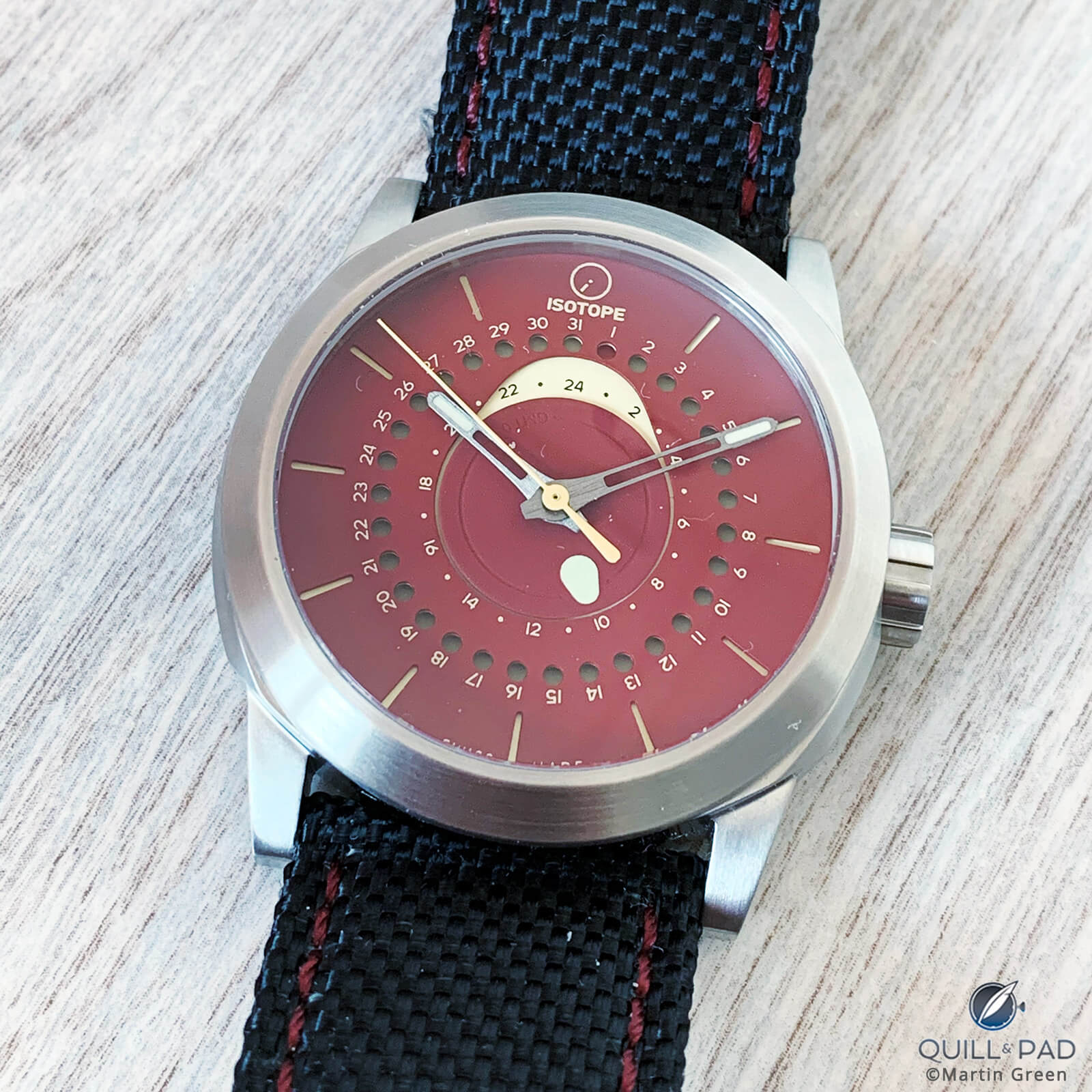
Isotope GMT 0°
Five years later, I feel that the brand has truly found its flow with the Isotope GMT 0º.
José was kind enough to lend me a prototype for this article, and it it oozes a quality that you normally have to shop for at the major brands to get. It has a lot of character generated from various unusual components.
The Mirandas are very particular about their design, they opted for a rather complex case with quite a few angles and a diameter of 41.5 mm. Not many brands would fit such a watch with a 24 mm strap like Isotope does, but it works very well. The wide strap makes the GMT 0º – whose name refers to the Prime Meridian in Greenwich – look smaller than it is. And it adds a lot of character.
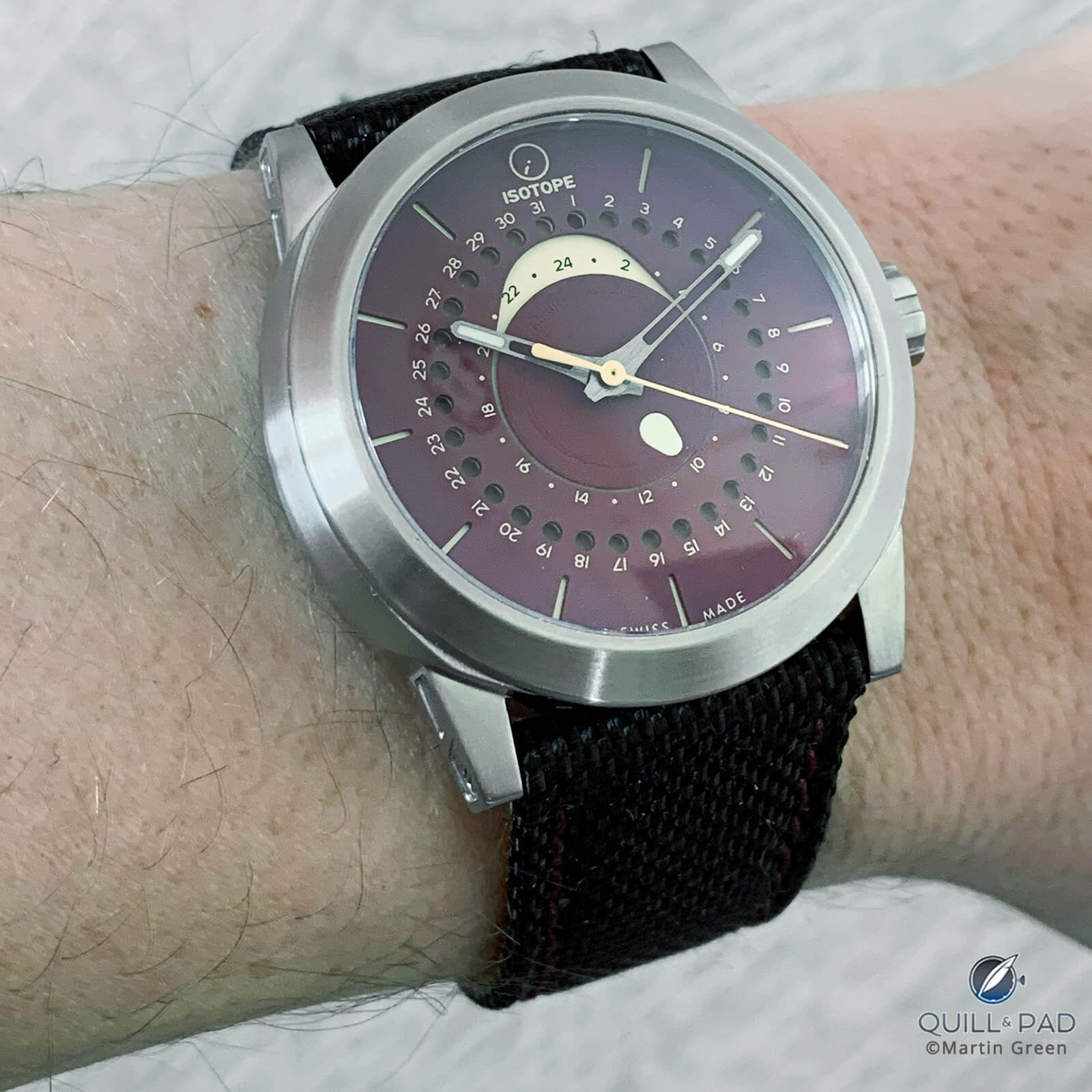
Isotope GMT 0° on the wrist
In terms of design, the Isotope seems to flirt with brands like ochs und junior and Ikepod, but more in style than execution.
The dial displays the second time zone by a disk, which is indicated by the so-called “lacrima” marker – Latin for “tear(drop)” – a shape that Isotope repeats throughout the watch.
The dial has two levels and cleverly uses this to full advantage –the date indication, for example, which uses holes in the dial under which a red marker moves to indicate the appropriate number. Its legibility is sufficient on the prototype, but will be further improved in the production model.
The Mirandas also like to experiment with color, obvious in the rare ruby red dial inspired by the color of Port wine combined with a peach-colored second hand on the model I borrowed.
This color combination works well, introducing a fun element to an otherwise relatively serious looking watch. A green-dialed version follows with an orange second hand, and also available is a limited edition with a black DLC-coated case. For people with less daring tastes, Isotope also offers the GMT 0º with a white or blue dial.
Contrary to the two other watches in this roundup, the movement of the Isotope is visible – or at least part of it. Through a teardrop-shaped cutout in the case back, we can admire part of the balance wheel and the oscillating weight.
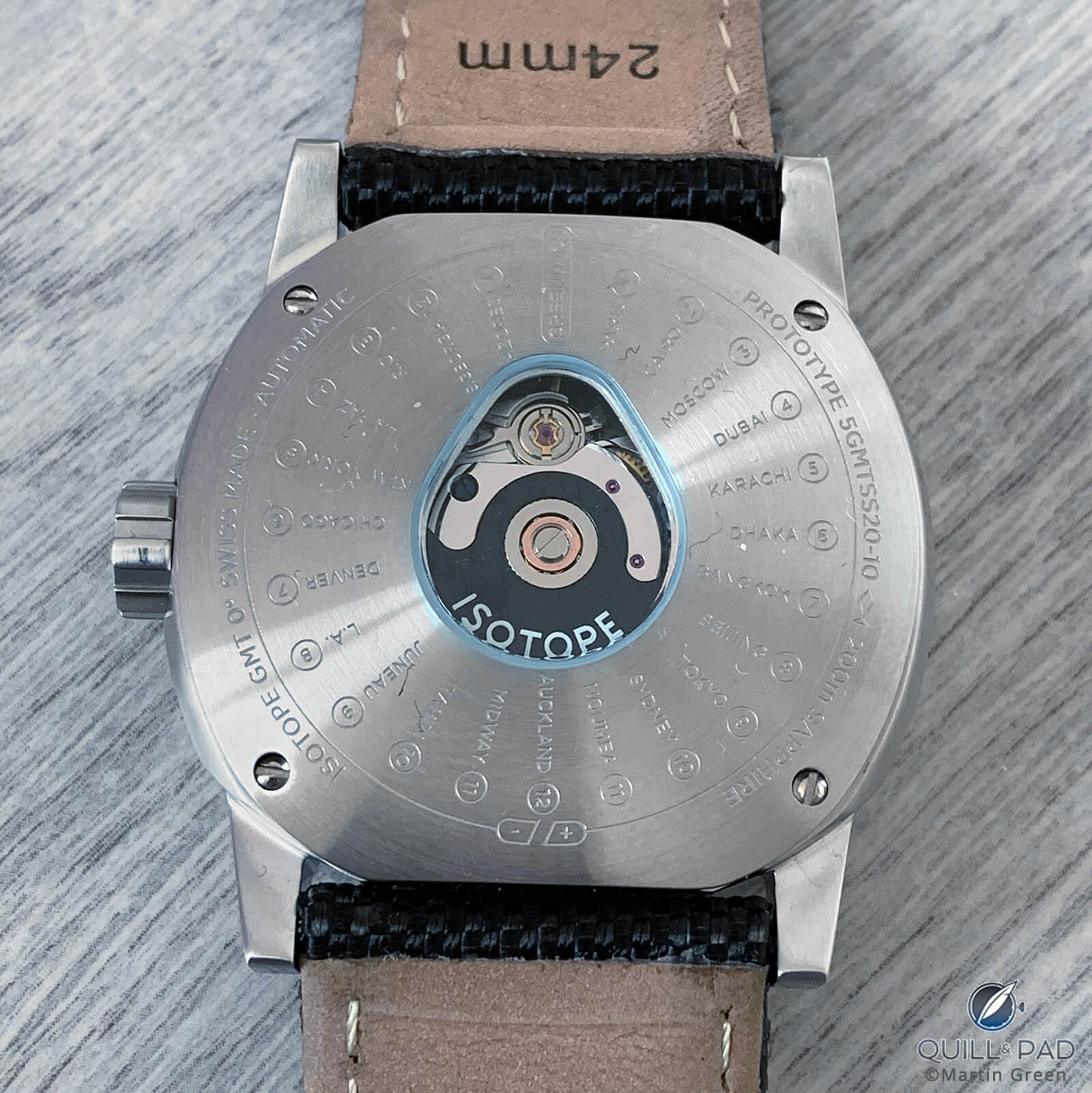
Back of the Isotope GMT 0°
The cutaway is surrounded by a convenient engraving of the different time zones, while four visible screws secure the case back. With a water resistance of 200 meters, the GMT 0º also offers an unexpected level of robustness, which you want in a travel watch.
The movement itself is a customized automatic caliber from Swisstech, which performs along the lines of the movements in the Maurice Lacroix and Montblanc.
José was not yet happy with the quality of the strap the prototype came on, and I concur. It was the only part of the watch where I felt quality was not yet up to par, and the stiffness of the strap also reduced wearing comfort. The buckle is quite well finished and original in design. It is screwed into the strap, like the lugs, but it is a tad bulky relative to the size of the watch.
But this is nitpicking as the Isotope GMT 0° both offers a tempting value proposition and makes for a travel companion that is neither too dressy nor too sportive. The GMT 0º could quite easily become a go-to watch when it is time to take off.
For more information, please visit www.isotopewatches.com/collections/watches/products/isotope-gmt-zero-degrees.
Quick Facts Isotope GMT 0°
Case: 41 x 14.2 mm, stainless steel or black DLC-coated stainless steel , sapphire crystal, 200 meters water resistance
Movement: automatic Swisstech Caliber S24-45, 4 Hz/28,800 vph frequency, 40-hour power reserve
Functions: hours, minutes, seconds; date, second time zone
Price: £710 (blue, olive green, or white dial, stainless steel case); £820 (ruby red dial, stainless steel case, limited to 49 pieces), £820 (olive green dial, stainless steel case with black DLC coating, limited to 49 pieces); 15% discount during pre-order until mid-May
Remark: three-year warranty
You may also enjoy:
Maurice Lacroix Masterpiece Triple Retrograde: Great Looks And Excellent Value
Montblanc 1858 Geosphere: Travel Never Looked So Good
Montblanc 2019 Heritage Line: Minerva More Visible Than Ever. And That Is So, So Good
Leave a Reply
Want to join the discussion?Feel free to contribute!





















































Can I wear any of these?
Difficult to know without the lug to lug measurements.
Hi Jeff, the watch case’s diameter and height are the typical measurements we need to know if it’s a watch we can and would wear. Lug-to-lug measuring is in my experience only done when you need to buy a new strap. But the best test is just trying them on.
Lug width is the measurement you need for straps. Lug-to-lug measures the overall length of the watch on your wrist and is a useful measurement to know how it look on your wrist. There are 40mm watches with 50mm lug-to-lug that wear significantly bigger than a 42mm watch with a 47mm lug-to-lug. See here: https://timeandtidewatches.com/lug-to-lug/
Lug to lug is very important to know! It has nothing to do with lug width.
Hi Jeff
If you’re in London or nearby, we can have a coffee (or tea…) and you can try the Isotope GMT 0º.
Cheers!
Funny she didn’t know that ! I think everybody reading about watches for a few weeks comes a cross that complaint of the wear ability of watches that appear to be on the margin.
Am I the only one who is bothered by the positioning of the 24 hour dial? IMHO, 12 noon should be at the top of the dial, and 24 midnight, should be at the bottom. Sure wish I could find a watch face setup like that.
You write that your gmt watches fall in the budget area. I feel that a cost over
2000 Euros puts your choices in a moderate to expensive group .
Your choices are well taken but the costs are expensive.
Do any of these movements have jumping local hour capability? To me that is essential for a GMT complication.
I really like the design of that Maurice Lacroix, but why made the case 43mm if the movement inside is substantially smaller? 40-41mm would’ve been perfect for me. I also dislike the screws in the back although if they’re not advertising the water resistance depth, then they most likely don’t see this watch as a diver.
Whenever I travel, I take a Suunto Vector. It keeps amazing time and I use the compass function often as I explore new places. It’s great to be able to check the temperature too, which is why I often wear it on the strap of my pack. But most importantly, NOBODY WANTS TO STEAL IT. Wearing an expensive watch and toting a serious camera while looking lost is just asking for trouble.